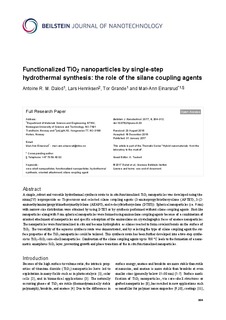| dc.contributor.author | Dalod, Antoine Robert Marie | |
| dc.contributor.author | Henriksen, Lars | |
| dc.contributor.author | Grande, Tor | |
| dc.contributor.author | Einarsrud, Mari-Ann | |
| dc.date.accessioned | 2017-04-28T11:27:33Z | |
| dc.date.available | 2017-04-28T11:27:33Z | |
| dc.date.created | 2017-03-23T08:27:48Z | |
| dc.date.issued | 2017 | |
| dc.identifier.citation | Beilstein Journal of Nanotechnology. 2017, 8 304-312. | nb_NO |
| dc.identifier.issn | 2190-4286 | |
| dc.identifier.uri | http://hdl.handle.net/11250/2441234 | |
| dc.description.abstract | A simple, robust and versatile hydrothermal synthesis route to in situ functionalized TiO2 nanoparticles was developed using titanium(IV) isopropoxide as Ti-precursor and selected silane coupling agents (3-aminopropyltriethoxysilane (APTES), 3-(2-aminoethylamino)propyldimethoxymethylsilane (AEAPS), and n-decyltriethoxysilane (DTES)). Spherical nanoparticles (ca. 9 nm) with narrow size distribution were obtained by using DTES or by synthesis performed without silane coupling agents. Rod-like nanoparticles along with 9 nm spherical nanoparticles were formed using aminosilane coupling agents because of a combination of oriented attachment of nanoparticles and specific adsorption of the aminosilane on crystallographic faces of anatase nanoparticles. The nanoparticles were functionalized in situ and became hydrophobic as silanes reacted to form covalent bonds on the surface of TiO2. The versatility of the aqueous synthesis route was demonstrated, and by selecting the type of silane coupling agent the surface properties of the TiO2 nanoparticles could be tailored. This synthesis route has been further developed into a two-step synthesis to TiO2–SiO2 core–shell nanoparticles. Combustion of the silane coupling agents up to 700 °C leads to the formation of a nanometric amorphous SiO2 layer, preventing growth and phase transition of the in situ functionalized nanoparticles. | nb_NO |
| dc.language.iso | eng | nb_NO |
| dc.publisher | Beilstein-Institut | nb_NO |
| dc.rights | Navngivelse 4.0 Internasjonal | * |
| dc.rights.uri | http://creativecommons.org/licenses/by/4.0/deed.no | * |
| dc.title | Functionalized TiO2 nanoparticles by single-step hydrothermal synthesis: the role of the silane coupling agents | nb_NO |
| dc.type | Journal article | nb_NO |
| dc.type | Peer reviewed | nb_NO |
| dc.source.pagenumber | 304-312 | nb_NO |
| dc.source.volume | 8 | nb_NO |
| dc.source.journal | Beilstein Journal of Nanotechnology | nb_NO |
| dc.identifier.doi | 10.3762/bjnano.8.33 | |
| dc.identifier.cristin | 1460463 | |
| dc.description.localcode | This is an Open Access article under the terms of the Creative Commons Attribution License(http://creativecommons.org/licenses/by/4.0), which permits unrestricted use, distribution, and reproduction in any medium, provided the original work is properly cited. The license is subject to the Beilstein Journal of Nanotechnology terms and conditions:(http://www.beilstein-journals.org/bjnano) The definitive version of this article is the electronic one which can be found at:doi:10.3762/bjnano.8.33 | nb_NO |
| cristin.unitcode | 194,66,35,0 | |
| cristin.unitcode | 194,66,1,0 | |
| cristin.unitname | Institutt for materialteknologi | |
| cristin.unitname | NT fakultetsadministrasjon | |
| cristin.ispublished | true | |
| cristin.fulltext | original | |
| cristin.qualitycode | 1 | |

